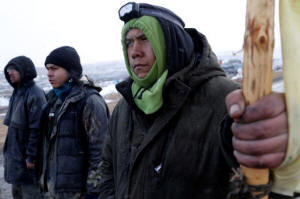|
U.S. judge rules against tribes seeking
to stop Dakota pipeline
 Send a link to a friend
Send a link to a friend
 [March 08, 2017]
By Timothy Gardner [March 08, 2017]
By Timothy Gardner
(Reuters) - A U.S. judge on Tuesday ruled
against Native American tribes seeking to stop the Dakota Access
Pipeline as their legal options narrow weeks before oil is set to flow
on the project.
Judge James Boasberg of the U.S. District Court for the District of
Columbia rejected the tribes' request for an injunction to withdraw
permission issued by the Army Corps for the last link of the oil
pipeline under Lake Oahe in North Dakota.
Energy Transfer Partners LP <ETP.N> is building the $3.8 billion
pipeline to move crude from the Northern Plains to the Midwest and then
on to the Gulf of Mexico.
The denial of the injunction represents yet another setback to the
tribes – the Standing Rock Sioux and the Cheyenne River Sioux – that
have been leading the charge against the line, which runs adjacent to
tribal territory in southern North Dakota.
The tribes had argued that the pipeline would render water they use for
religious ceremonies spiritually impure even if the pipeline goes under
Lake Oahe. They said the pipeline was reminiscent of an ancient prophesy
of a Black Snake that would harm natives and that they could not use
other water supplies in the region because they had been polluted by
decades of mining.

Boasberg said in a written ruling that the Cheyenne tribe "remained
silent as to the Black Snake prophesy and its concerns about oil in the
pipeline under Lake Oahe" during two years of legal disputes against the
line.
Chase Iron Eyes, lead counsel for the Lakota People's Law Project said
"it is simply unacceptable that the government is allowing Energy
Transfer Partners to build this pipeline through our sacred lands." The
water the pipeline threatens supplies used by the Lakota and more than
17 million other people downstream, he said.
The tribes had won a reprieve from the Democratic Obama administration
in early December, but the victory was short-lived as Republican
President Donald Trump signed an executive order days after taking
office on Jan. 20 that smoothed the path for the last permit needed.
Energy Transfer Partners needed only to cross beneath Lake Oahe, part of
the Missouri River system, to connect a final gap in the 1,170-mile
(1,885-km) pipeline, which will move oil from the Bakken shale formation
to a terminus in Illinois.
The company said in a filing late Monday that it plans to start pumping
oil through a section of the line under the Missouri River by the week
of March 13.
Lisa Dillinger, a spokeswoman for the pipeline, said the company was
pleased with Boasberg's decision and that it has "progressed quickly
with the final piece of construction."
[to top of second column] |

Ezekiel Bahee, 18, of the Navajo Tribe of Arizona, stands with other
opponents of the Dakota Access oil pipeline as they prepare to
confront police calling for them to evacuate their main camp near
Cannon Ball, North Dakota, U.S., February 22, 2017. REUTERS/Terray
Sylvester

FIGHT CONTINUES
An oil analyst said the pipeline would help slash transportation
costs for producers in the Bakken, one of their biggest expenses.
He predicted that the ruling and the Trump administration's pro-oil
stance could clear the way for more pipelines. "If we're setting
precedent where we're building pipelines without real restrictions,
I think this is a kickoff to what's going to happen in the next few
years,” said Carl Larry, president of Oil Outlooks and Opinions.
Public opposition to the pipeline drew thousands of people to the
North Dakota plains last year, including high-profile political and
celebrity supporters, along with veterans’ groups upset by the use
of force by law enforcement.
After the legal victory in December, Standing Rock Sioux chairman
Dave Archambault II asked protesters to leave; the primary protest
camp on federal land was evacuated by mid-February, though
substantial cleanup remains. The last protesters burned structures
as they left the camp.
Archambault said that his tribe and its allies will continue to
fight larger legal battles in the case, including the legality of
the permitting. The court will next consider issues including the
tribes' effort to stop the pipeline from operating until the Army
Corps completes an environmental impact assessment that Trump's
executive order cut short.

"The fight against the pipeline has changed, but it continues with
as much strength as ever," Archambault said.
(Reporting by Timothy Gardner and Valerie Volcovici in Washington
and David Gaffen, Catherine Ngai in New York; editing by Jonathan
Oatis)
[© 2017 Thomson Reuters. All rights
reserved.]
Copyright 2017 Reuters. All rights reserved. This material may not be published,
broadcast, rewritten or redistributed. |